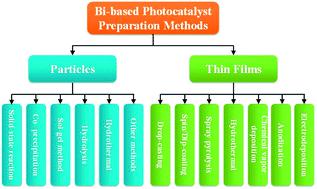当前位置:
X-MOL 学术
›
J. Mater. Chem. A
›
论文详情
Our official English website, www.x-mol.net, welcomes your feedback! (Note: you will need to create a separate account there.)
Preparation of Bi-based photocatalysts in the form of powdered particles and thin films: a review
Journal of Materials Chemistry A ( IF 11.9 ) Pub Date : 2020-03-23 , DOI: 10.1039/d0ta01180k Xuelian Wu 1, 2, 3, 4, 5 , Cui Ying Toe 6, 7, 8, 9, 10 , Chenliang Su 1, 2, 3, 4, 5 , Yun Hau Ng 11, 12, 13, 14 , Rose Amal 6, 7, 8, 9, 10 , Jason Scott 6, 7, 8, 9, 10
Journal of Materials Chemistry A ( IF 11.9 ) Pub Date : 2020-03-23 , DOI: 10.1039/d0ta01180k Xuelian Wu 1, 2, 3, 4, 5 , Cui Ying Toe 6, 7, 8, 9, 10 , Chenliang Su 1, 2, 3, 4, 5 , Yun Hau Ng 11, 12, 13, 14 , Rose Amal 6, 7, 8, 9, 10 , Jason Scott 6, 7, 8, 9, 10
Affiliation

|
Bismuth-based semiconductors, as an emerging group of photocatalysts possessing a layered-structure, have been widely demonstrated to show excellent photo-oxidation capability in water oxidation and pollutant decomposition. Deriving from the suitable band gap and well-dispersed valence band, Bi-based materials are generally visible-light-responsive and consequently have received considerable interest in photocatalysis. Different from conventional binary metal oxide semiconductors, the synthesis of Bi-based materials needs to be carefully controlled as most of them are prepared as ternary oxide materials that comprise multiple elements and are sensitive to the synthesis conditions. Specifically, different methods need to be employed to obtain suspended particles and electrodes for photocatalytic and photoelectrochemical reactions, respectively. Given that the synthesis process for photoelectrodes usually involves more than one step, fabricating the desired ternary Bi-based photoelectrodes can be more challenging when compared to powdered photocatalysts. With the significant emergence of Bi-based materials, understanding the effect of different synthesis methods on the catalyst properties is crucial to ensure great performance. This review summarizes recent developments in Bi-based photocatalysts by comparing and discussing various synthesis approaches for powdered photocatalysts and thin film photoelectrodes.
中文翻译:

粉末状颗粒和薄膜形式的Bi基光催化剂的制备:综述
铋基半导体作为一种新兴的具有层状结构的光催化剂,已被广泛证明在水氧化和污染物分解中显示出优异的光氧化能力。源自合适的带隙和良好分散的价带,Bi基材料通常具有可见光响应性,因此在光催化方面引起了相当大的兴趣。与常规的二元金属氧化物半导体不同,Bi基材料的合成需要仔细控制,因为它们中的大多数被制备为包含多种元素并且对合成条件敏感的三元氧化物材料。具体地,需要采用不同的方法来分别获得用于光催化和光电化学反应的悬浮颗粒和电极。鉴于光电极的合成过程通常涉及一个以上的步骤,因此与粉状光催化剂相比,制造所需的三元Bi基光电极可能更具挑战性。随着Bi基材料的大量出现,了解不同合成方法对催化剂性能的影响对于确保出色的性能至关重要。这篇综述通过比较和讨论粉状光催化剂和薄膜光电极的各种合成方法,总结了Bi基光催化剂的最新进展。理解不同合成方法对催化剂性能的影响对于确保出色的性能至关重要。这篇综述通过比较和讨论粉状光催化剂和薄膜光电极的各种合成方法,总结了Bi基光催化剂的最新进展。理解不同合成方法对催化剂性能的影响对于确保出色的性能至关重要。这篇综述通过比较和讨论粉状光催化剂和薄膜光电极的各种合成方法,总结了Bi基光催化剂的最新进展。
更新日期:2020-03-23
中文翻译:

粉末状颗粒和薄膜形式的Bi基光催化剂的制备:综述
铋基半导体作为一种新兴的具有层状结构的光催化剂,已被广泛证明在水氧化和污染物分解中显示出优异的光氧化能力。源自合适的带隙和良好分散的价带,Bi基材料通常具有可见光响应性,因此在光催化方面引起了相当大的兴趣。与常规的二元金属氧化物半导体不同,Bi基材料的合成需要仔细控制,因为它们中的大多数被制备为包含多种元素并且对合成条件敏感的三元氧化物材料。具体地,需要采用不同的方法来分别获得用于光催化和光电化学反应的悬浮颗粒和电极。鉴于光电极的合成过程通常涉及一个以上的步骤,因此与粉状光催化剂相比,制造所需的三元Bi基光电极可能更具挑战性。随着Bi基材料的大量出现,了解不同合成方法对催化剂性能的影响对于确保出色的性能至关重要。这篇综述通过比较和讨论粉状光催化剂和薄膜光电极的各种合成方法,总结了Bi基光催化剂的最新进展。理解不同合成方法对催化剂性能的影响对于确保出色的性能至关重要。这篇综述通过比较和讨论粉状光催化剂和薄膜光电极的各种合成方法,总结了Bi基光催化剂的最新进展。理解不同合成方法对催化剂性能的影响对于确保出色的性能至关重要。这篇综述通过比较和讨论粉状光催化剂和薄膜光电极的各种合成方法,总结了Bi基光催化剂的最新进展。


























 京公网安备 11010802027423号
京公网安备 11010802027423号